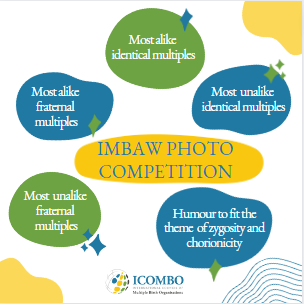
International Multiple Birth Awareness Week 2022
7 – 13 November
Zygosity and chorionicity matter

Why does knowing chorionicity and zygosity matter?
Despite improvements in science, incorrect information on whether twins are monozygotic or dizygotic is still given to twins and their parents. In some countries, chorionicity is still not always correctly determined. That is why it is important we raise awareness and help people understand what zygosity and chorionicity mean and the implications of knowing about them.
Chorionicity, rather than zygosity, is the main determinant of the outcome in twin pregnancies.
Monochorionic twins are at greater risk of complications than dichorionic twins. These complications include twin-to-twin transfusion syndrome (TTTS), twin anaemia-polycythaemia sequence (TAPS), selective fetal growth restriction (FGR) and twin reverse arterial perfusion syndrome (TRAP). For this reason, the early determination of chorionicity in multiple birth pregnancies is very important in order to manage the pregnancy appropriately, e.g. more frequent, detailed scanning, testing and intervention if needed. In addition, accurate knowledge of zygosity can be important for a range of reasons including medical, personal, financial, scientific, legal and ethical considerations.
The goal for IMBAW 2022 was to raise awareness around identical versus fraternal twins, and higher order multiples, as well as the importance of determining chorionicity early in pregnancy.
Each day we had a focus on a particular area:
● Day 1: Explaining zygosity and chorionicity
● Day 2: A focus on identical twins
● Day 3: A focus on fraternal twins
● Day 4: Determining zygosity (testing and questionnaire) and chorionicity
● Day 5: Differences between MC and DC (management, complications of MC pregnancies)
● Day 6: Pros/cons of knowing zygosity
● Day 7: Misdiagnosis of zygosity/chorionicity
Click here for more information on zygosity and chorionicity.

In conjunction with the awareness week, ICOMBO had a photo competition.
For further information contact ICOMBO Chairperson at chair@icombo.org